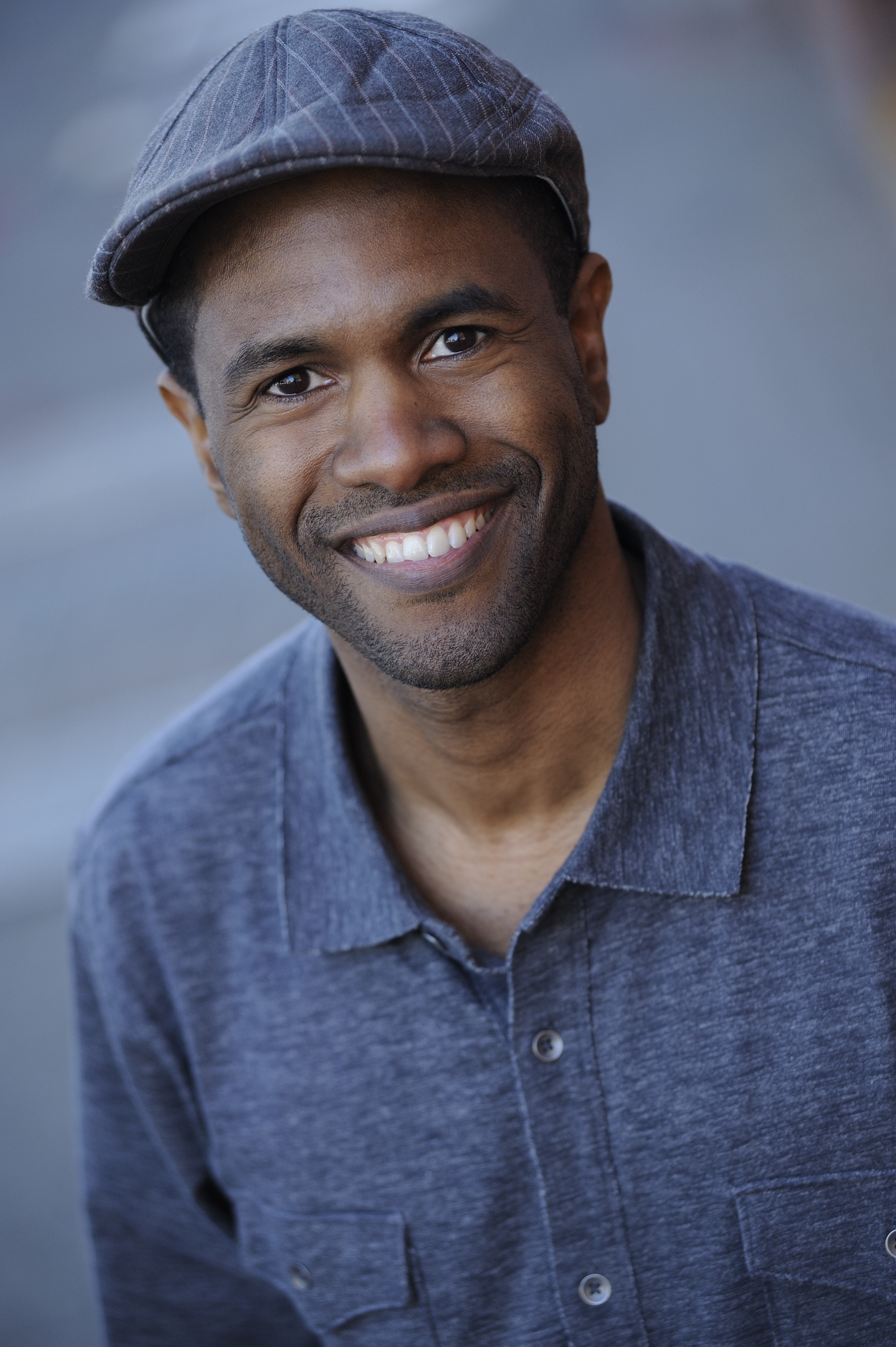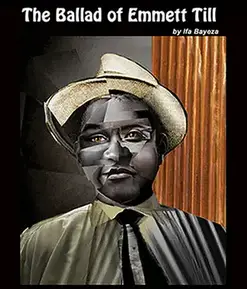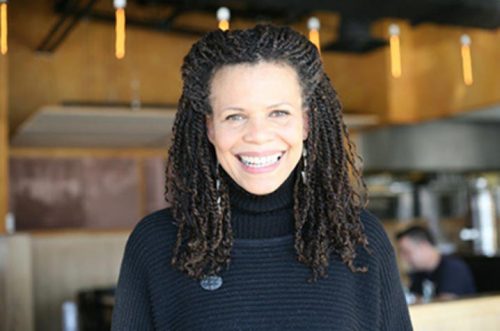Sit back relax
and put ya programs away
…
If ya ignant
You gon learn today
—The Ring Master in The Blackest Battle

Raymond O. Caldwell’s realization of Psalmayene 24’s The Blackest Battle — a graphic novel come to life as a hip-hop musical — is a feast of virtuosity. Whereas some have been frustrated with not having access to live theater, Theater Alliance has taken this opportunity to offer something that some of us might not sit still for in the usual sanctum sanctorum of live theater. In fact, the point of this production is kind of to make us not be able to (or want to) sit still or sit back. The Blackest Battle presents theater that more fully engages the potential of hip-hop than is often possible in “legit” stages where traditional audiences may come with curated expectations and sometimes merely tolerate the hip-hop form and keep its power at a distance.
This production, though onscreen, is an immersive experience. Whereas much theater keeps technology in the background, so as not to disturb the illusion it is intending to produce, this production puts technology center stage, using it to reflect the way we use technology in our daily lives. It is delightful and enticing in its form and it is harrowing in its emotional impact. It’s a monumental accomplishment. And it is not to be missed.

Many people experience Shakespeare as someone literally on a pedestal to be worshipped and his works memorized. However, some people have been able to experience him as an innovator of language and form. That innovation of language and form seems to be something that this show resonates with, treating Shakespeare more like a warrior on the same battlefield with some of the same goals, whose work is to be relied upon, appreciated, and inspired by rather than someone out of reach. When a segment of Romeo and Juliet is read by Dream (Imani Branch), a member of the rap crew Key Enterprises, it doesn’t even seem out of place with the hip-hop universe. Take a look.
From Romeo and Juliet:
For beauty starved with her severity
Cuts beauty off from all posterity.
She is too fair, too wise, wisely too fair,
To merit bliss by making me despair:
She hath forsworn to love and in that vow
Do I live dead, that live to tell it now.
Bonita, from The Blackest Battle:
The reality is that I was born with my sexuality
And I refuse to be a casualty of your brutality
I know that I’m charged up now like a new battery
But that’s cause the situation’s rotten like a cavity
I’m talkin’ bout the judgment and discrimination
Cuzz I’ll never have husband some folks stay hatin’
Battle uses Romeo and Juliet for its plot structure. Through that structure the show addresses the ongoing struggle of African Americans to survive the pressures put on them by this country.
In a future, described by our narrator, The Ring Master (portrayed with sensual confidence by Kelsey Delemar), as being “distant enough to feel remote, but close enough to be familiar,” the United States has experienced a second Civil War and reparations to descendants of enslaved Africans have been made. It is well known that in Chief County, a reparations settlement that is run and controlled by Black folks, Black people in this enclave often kill each other.
The Capulets and the Montagues in Chief County are the two rap crews Lock Music and Key Enterprises. Do or Die (a formidable and wily Louis Davis), the leader of Key Enterprises, insists that his group’s music remind its audience of the situations they are living in so that they can organize themselves to address those situations. He is fiercely opposed to his group members using Hope, the drug of choice in Chief County. He fires group member Bonita (the indomitable Jade Jones), who has reneged on her promise to stop using it. Dream (Imani Branch, living up to her character’s name) is Do or Die’s cousin and a member of the group. She defends Bonita, pointing out that they need someone to supply beats for this evening’s Fourth of July rent party.

On the other side of town, Sgt. Pepper (an eager, trigger-happy party animal, Bayou Elom), the leader of Lock Music, is determined to provide joy for his audiences, relief from the pressures they are living under. Group member Bliss (Gary Perkins, living up to his character’s name) is the soft-spoken, innovative poet, and Ty (a forceful and trustworthy Emmanuel Kyei-baffour) is the group’s dress-wearing DJ, who needs to upgrade his skills in order for the group to move to the next level and meet the challenge of opening for the top-rated group in the county.
At the set-up for the rent party, Bliss and Dream make eye contact across a crowded room and fall in love at first sight. They slip away to watch the fireworks from the pier. The pier — which is the dividing line between East and West Chief County, a place where the soothing presence of a body of water can be experienced, and the place where, in the past, cargoes of enslaved Africans were delivered — has become an unofficial safe zone.
It starts to rain and Dream and Bliss take shelter under The Bridge, the underside of which is covered with the names of people who have been killed in Chief County. They are joined there by the Ringmaster who affirms the rightness of their efforts to be open to loving each other. Shortly thereafter the other members of Lock Music and Key Enterprises show up, having decided to settle their rivalry “the Darwinian way.” They demand that Bliss and Dream separate from each other and rejoin their respective teams. Gunshots are fired and the Ring Master is killed. The remaining people leave the scene while the Ringmaster speaks a posthumous plea:
The Ring Master:
Spittin to you from the other side
You just caught a glimpse of the way that I died
…
Hush sweet darlin’ don’t you cry
This is just fiction, a slum village lullaby
But it’s also an alarm clock
Meant to wake you up like a five a.m. gunshot
It’s just a function of the play’s plot
…
A last-ditch effort, what the hell and the blood claat
Maybe we should burn down all the gun shops
Cuz come the fire or the flood, the violence it must stop
It must stop, it must stop, it must stop
This production reminded me of the technological achievements of Spiderman: Into the Spiderverse: there is more here than you can possibly take in on a single viewing. Visually we are, from the beginning, in more than one place at once. We are in this present pandemic and in this future calamity. We are in a hyperpoetic theater space, a graphic novel space, but also in a naturalistic film space and an animated space.
But where Spiderman was clearly a movie, with a fourth wall, Battle still feels like theater (with a kind of Dr. Who-ish flavor). In The Blackest Battle the sets are colored backdrops or projections that shift shape and formation the way a frame does in a graphic novel or comic strip. Characters’ phone controls light up on their fingers (thanks to finger-cap touchscreen technology developed by Preston Bezos, illegitimate son of Jeff Bezos, “a real microchip off the old block”) and the text or video of conversations is projected on screens that the audience can see through and read, if they’re fast enough. It’s an environment that the audience gets to imagine living in and that it discovers along with the cast.

Gary Perkins as Lock Crew member Bliss and Imani Branch as Key Enterprises member Dream in in ‘The Blackest Battle.’ Photo courtesy of Theater Alliance.
This multi-visual, technologically overcharged world onstage reflects the world we all live in offstage — a highly surrealistic world — made so largely by the contradictory dictates of white supremacy upon our lives. A world in which the words that come out of your mouth and the plot turns that your life takes can sound like a “corny movie from the 1980s or some sappy Elizabethan play.”
In Battle, Psalmayene 24 wrestles with inherited, dictated, and curated forms of theater the way Jacob wrestled with the angel in the Hebrew scriptures. The Blackest Battle is definitely a musical. I’m 70 years old, raised in mid-20th-century COGIC culture. I used to be concerned about not being able to relate to hip-hop. But experiencing The Blackest Battle, I found I no more needed to understand hip-hop to be lifted and carried away by the integrity and earnest and steadfast warriorship it offers than I need to understand Viennese operetta to be engaged with Showboat.
What can you say about the love story? It’s delightful. Surely no one has ever been this young, zestful, and beautiful. Which is why they are named Dream and Bliss, I guess: and why the main lyrics to their love song are “Da-da-da, da-da-da, da-da-da.” Imani Branch and Gary Perkins invest a sincerity and a disciplined craftsperson’s respect for and faith in their material. They neither short-change nor rush anything. Wow, does that investment ever pay off!
Two scenes were notably thought-provoking for me: the interruption of the love scene The Ringmaster makes in order to ensure that we understand what the drug Hope is, and the animated, historical accounting of African American mistreatment that Dream and Bliss experience while under the influence of the drug Hope.

The Ring Master presents us with a corporate-slick promotional announcement for Hope in which all the researchers, clients, and manufacturers shown in clean, well-lighted rooms are white. And they look suspiciously like professional actors hired to do an industrial film. While whenever Hope is being actively used by consumers, or sold in shadowy street locations, it is in the bodies and hands of Black folks. The presentation of Hope as a drug and the suggestion that Black folks could be addicted to it is disturbing (remember the quick announcement of forgiveness for Dylan Roof?). How does one live without it? What does one put in its place?
The Blackest Battle is a thrilling experience that is guaranteed to entertain, challenge, and inspire its audience.
Running Time: Approximately 90 minutes.
The Blackest Battle premiered July 31, 2021, and will be available for scheduled online streams through the month of August. Tickets (General Admission, $25 – $30; Seniors/Students/Military, $20 – $25; Radical Neighboring, $15) are available online or by calling 202-241-2539.
Read the full article by Gregory Ford for DC Metro Theater Arts here.












